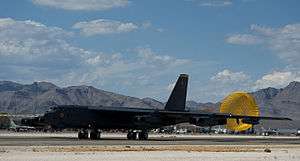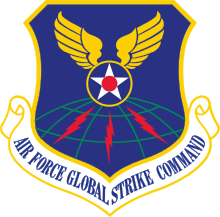69th Bomb Squadron
69th Bomb Squadron
 | |
|---|---|
 | |
| Active | 1940–1993; 2009-present |
| Country |
|
| Branch |
|
| Type | Squadron |
| Role | Bombardment |
| Part of | Global Strike Command |
| Garrison/HQ | Minot Air Force Base |
| Nickname(s) | Knighthawks |
| Colors | Gray/yellow |
| Engagements |
OIR OFS Southwest Pacific Theater Desert Storm[1] |
| Decorations |
Distinguished Unit Citation Air Force Outstanding Unit Award Philippine Presidential Unit Citation[1] |
| Insignia | |
| 69th Bombardment Squadron emblem (approved 20 January 145)[1] |
 |
The 69th Bomb Squadron is an active United States Air Force unit. After being inactivated on 31 December 1993, it was reactivated on 3 September 2009 at Minot Air Force Base, and assigned to the 5th Bomb Wing. The squadron operates Boeing B-52H Stratofortress aircraft.
History
World War II
Established as a pre-World War II GHQAF bombardment squadron; equipped with Douglas B-18 Bolos and early-model Martin B-26 Marauders. After the Japanese Attack on Pearl Harbor, squadron was engaged in antisubmarine operations over the mid-Atlantic coast. Reassigned to Third Air Force and equipped with A-26 Invader light bombers; deployed to Fifth Air Force in Australia in 1942 as part of the re-equipping of that command after its withdraw to Australia after the 1941-1942 Battle of the Philippines.
Deployed to Southwest Pacific Area; being assigned to Thirteenth Air Force and attacking enemy targets in the Solomon Islands; New Hebrides and other enemy locations north and east of Papua New Guinea. Became part of Mac Arthur's New Guinea campaign, supported Army ground forces with tactical bombing of enemy formations and targets along the northern coast of New Guinea and in the Netherlands East Indies.
Attacked enemy forces in the Philippines during early 1945 as part of the liberation from Japanese control; continued combat missions until the Japanese capitulation in August 1945. Became part of the Fifth Air Force forces in Occupied Japan in 1946 before being demobilized and inactivated in May 1946.
The 69th was awarded a Distinguished Unit Citation for its pre-invasion bombing of Balikpapan between 23 and 30 June 1945. Balikpapan was a center for oil refining on Borneo held by the Japanese. These attacks included bombing and strafing enemy shore installations. The round trip to the target was over 1700 miles and was among the longest flown by medium bombers during the war. Pre mission experiments determined that the squadron's bombers could carry a bomb load over this distance with fuel tanks installed in their radio compartments despite having to take off from a runway damaged by enemy action. Four of the missions encountered severe tropical weather fronts. Despite intense and accurate flak, the squadron destroyed gun positions, warehouses, roadblocks, fuel and ammunition dumps, a radar station as well as huge stores of gasoline and oil which the enemy had placed in position to be released into shallow pits oil the beach and ignited when the Australian ground troops made their assaults. The group attacked the beach while naval underwater demolition teams operated offshore without losing a man. The attacks were so effective that the Australian Seventh Division was able to come ashore without enemy opposition.[2]
Cold War
The 69th was reactivated as a Strategic Air Command Convair B-36 Peacemaker bombardment squadron in 1953. Engaged in worldwide training missions with the B-36 until 1956 when re-equipped with the jet Boeing B-52 Stratofortress. Deployed personnel and aircraft to Andersen Air Force Base, Guam and U-Tapao Royal Thai Navy Airfield, Thailand, for Operation Arc Light missions). Maintained nuclear alert until the end of the Cold War; Inactivated in 1991 with the drawdown of US Strategic forces.
Aircraft and personnel deployed to 1708th Provisional Bombardment Wing, Prince Abdulla AB, Jeddah, Saudi Arabia, Aug 1990-Mar 1991 (Operation Desert Storm); additional aircraft and personnel deployed in Dec 1990-Mar 1991. Aircraft and personnel deployed to 4300th Provisional Bombardment Wing, Diego Garcia AB, British Indian Ocean Territories, Jan-Mar 1991.
Post-Cold War
The 69th was reactivated in 2009 as part of Air Combat Command and transitioned to Air Force Global Strike Command in early 2010.[3]
Lineage
- Constituted as the 69th Bombardment Squadron (Medium) on 20 November 1940
- Activated on 15 January 1941
- Redesignated 69th Bombardment Squadron, Medium on 19 September 1944
- Inactivated on 10 May 1946
- Redesignated 69th Bombardment Squadron, Heavy on 19 February 1953
- Activated on 25 February 1953
- Redesignated 69th Bomb Squadron on 1 September 1991
- Inactivated on 31 December 1993
- Activated on 3 September 2009[1]
Assignments
- 38th Bombardment Group, 15 January 1941
- 42d Bombardment Group, 26 February 1943 – 10 May 1946
- 42d Bombardment Wing, 25 February 1953 – 1 September 1991
- 5th Bombardment Wing, 3 September 2009 – present[1]
Stations
|
|
Aircraft
- Douglas B-18 Bolo, (1941)
- Martin B-26 Marauder, (1941–1943)
- North American B-25 Mitchell, (1942–1946)
- Douglas A-26 Invader, (1942–1946)
- Convair B-36 Peacemaker, (1953–1956)
- Boeing B-52C Stratofortress (1956)
- Boeing B-52D Stratofortress (1957–1959)
- Boeing B-52G Stratofortress (1959–1991)
- Boeing B-52H Stratofortress (2009–present)
See also
References
Notes
- 1 2 3 4 5 6 Kane, Robert B. (November 23, 2009). "Factsheet 69 Bomb Squadron (ACC)". Air Force Historical Research Agency. Retrieved December 13, 2017.
- ↑ Cohn, Preface (quoting the citation for the award)
- ↑ "AIR FORCE GLOBAL STRIKE COMMAND". USAF Fact Sheet. Archived from the original on 17 February 2013. Retrieved 31 May 2013.
Bibliography
![]()
- Cohn, Major R. H.; et al. (2013) [1946]. The Crusaders: A History of the 42nd Bombardment Group (M) (Kindle ed.). Baton Rouge, LA: Army & Navy Pictorial Publications. ASIN B00BRSWTDA. Retrieved November 8, 2014.
- Maurer, Maurer, ed. (1982) [1969]. Combat Squadrons of the Air Force, World War II (PDF) (reprint ed.). Washington, DC: Office of Air Force History. ISBN 0-405-12194-6. LCCN 70605402. OCLC 72556.


.svg.png)